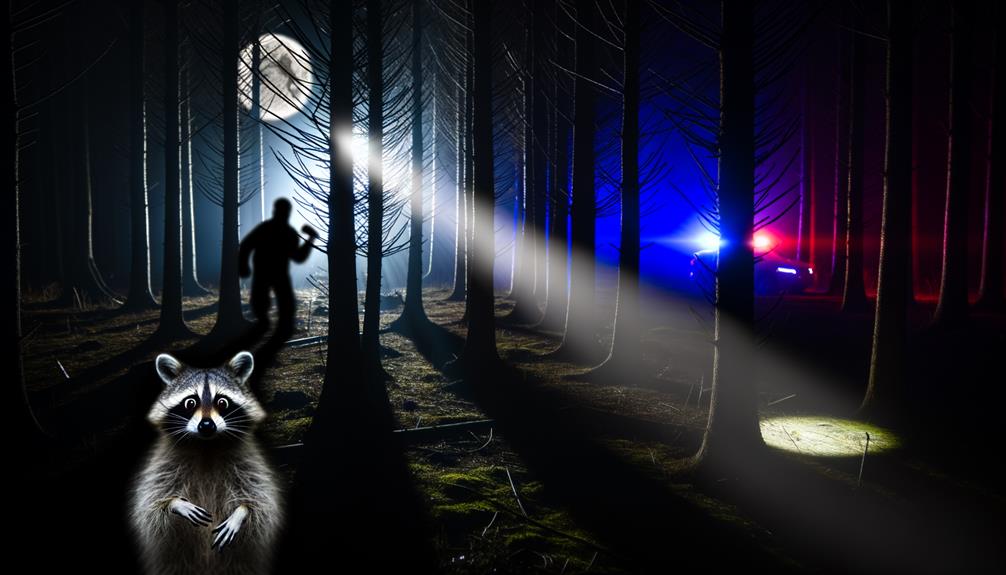Can You Go to Jail for Killing a Raccoon?
Yes, you can go to jail for killing a raccoon, depending on local wildlife protection laws. Raccoons are often classified as nuisance animals, but their killing is regulated by state-specific regulations.
Factors such as imminent threat, presence of disease, or danger to humans are considered. Unauthorized killing without proper justification can lead to severe legal penalties, including fines, community service, and imprisonment.
It's important to adhere to humane control methods or seek assistance from professional wildlife experts to mitigate legal risks. Understanding the complexities of these regulations is essential for responsible wildlife management.

Key Takeaways
- Killing raccoons can lead to jail time depending on local wildlife protection laws and regulations.
- Legal consequences vary; some areas impose fines, community service, or imprisonment for unauthorized raccoon killing.
- Justifying lethal action requires proving imminent threat or presence of rabies to avoid penalties.
- Compliance with state-specific regulations is essential; unauthorized killing can result in significant legal repercussions.
- Humane control methods, like exclusion or trapping, are recommended to manage raccoons legally and ethically.
Legal Status of Raccoons
Raccoons are often classified as nuisance animals, but their legal status varies greatly across different jurisdictions. In some areas, raccoons are protected under local wildlife conservation laws, making it illegal to harm or kill them without proper authorization.
Conversely, other regions may classify raccoons as pests, permitting more lenient control measures. Understanding the specific regulations in your jurisdiction is essential, as penalties for violating these laws can range from fines to imprisonment.
Homeowners dealing with raccoon infestations are advised to contact local wildlife management authorities to guarantee compliance with relevant legal requirements. This nuanced legal landscape underscores the importance of being well-informed before taking any action against raccoons.
Federal Wildlife Protection Laws
Federal wildlife protection laws, such as the Migratory Bird Treaty Act and Endangered Species Regulations, set stringent standards for the treatment of certain animals.
While raccoons are not typically covered under these specific statutes, legal hunting restrictions often still apply.
Understanding these laws is essential to ensuring compliance and avoiding potential legal consequences.
Migratory Bird Treaty Act
In the context of federal wildlife protection laws, the Migratory Bird Treaty Act serves as an essential piece of legislation that safeguards various species of birds across international boundaries.
Enacted in 1918, this Act makes it unlawful to pursue, hunt, take, capture, kill, or sell migratory birds, their eggs, or nests without proper authorization.
The statute is a result of treaties between the United States and other countries, including Canada, Mexico, Japan, and Russia. Its purpose is to prevent the extinction and guarantee the conservation of migratory bird populations.
Violations of the Act can lead to significant penalties, including fines and imprisonment, highlighting the importance of adherence to federal wildlife regulations.
Endangered Species Regulations
Beyond the protections offered by the Migratory Bird Treaty Act, the Endangered Species Act of 1973 serves as another pivotal federal law aimed at conserving species at risk of extinction. This legislation mandates the identification and protection of species deemed endangered or threatened and their critical habitats.
Under the Act, it is illegal to 'take' any listed species, with 'take' defined broadly to include harm, harass, capture, or kill. Violations can result in substantial penalties, including fines and imprisonment.
Although raccoons are not currently listed under this Act, understanding its scope is vital. The Act underscores the federal government's commitment to preventing species extinction and preserving biodiversity, reinforcing the legal framework for wildlife protection.
Legal Hunting Restrictions
Various federal wildlife protection laws impose strict legal hunting restrictions to maintain sustainable wildlife populations and ecosystem health. The Migratory Bird Treaty Act and the Bald and Golden Eagle Protection Act are prime examples of such legislation.
These laws mandate specific hunting seasons, quotas, and methods to prevent overexploitation. Violations can result in severe penalties, including substantial fines and imprisonment.
Additionally, the Endangered Species Act offers protections for species at risk of extinction, restricting activities that could harm their populations. Compliance with these regulations is essential for preserving biodiversity and ecological balance.
Hunters must be well-informed and adhere to these legal standards to avoid severe legal consequences and contribute to conservation efforts.
State-Specific Regulations
State-specific regulations on killing raccoons can vary significantly, reflecting the diverse legal and environmental priorities across different jurisdictions.
For instance, some states may classify raccoons as game animals, requiring specific permits and adherence to hunting seasons. In contrast, other states might consider raccoons as pests, allowing more lenient control measures.
Penalties for unauthorized killing can range from fines to imprisonment, depending on local wildlife protection laws. Additionally, states with endangered or threatened species considerations may impose stricter regulations to prevent collateral harm.
It is important to consult local wildlife authorities or legal professionals to make sure compliance with applicable laws, as ignorance of state-specific statutes does not exempt one from potential legal consequences.
Nuisance Animal Classification
Nuisance animal classification plays a pivotal role in determining the legal measures allowed for controlling raccoon populations. This classification typically includes animals that cause damage to property, pose health risks, or create persistent disturbances.
Depending on the jurisdiction, raccoons may be labeled as nuisance animals, granting property owners certain allowances for their removal. This can include trapping, relocation, or, in some cases, euthanasia. However, the specifics of what is permissible can vary significantly, influenced by local wildlife regulations and public health considerations.
It is essential to understand whether raccoons are classified as nuisance animals in your area before taking any action, as missteps can lead to legal repercussions, including fines or potential imprisonment.
Permits and Licenses
Understanding the classification of raccoons as nuisance animals is only the first step; securing the appropriate permits and licenses is often necessary to legally manage or remove these animals.
Regulations vary significantly by jurisdiction, with some areas necessitating a permit for trapping, relocating, or euthanizing raccoons. Wildlife control operators frequently need specific licenses to perform these actions professionally.
Homeowners may also be required to obtain permits, especially when dealing with protected species or specific local ordinances. Failure to comply with these regulatory requirements can result in fines, legal repercussions, and potentially, jail time.
It is essential to consult local wildlife authorities or regulatory agencies to make sure that all actions taken are within the bounds of the law.
Self-Defense Scenarios
In evaluating self-defense scenarios involving the killing of a raccoon, it is important to assess whether the animal posed an imminent threat to personal safety or property.
Understanding the criteria for imminent threat is vital, as it directly impacts the legal justification for such actions.
An overview of potential legal consequences will elucidate the boundaries of lawful self-defense and the risks of criminal charges.
Imminent Threat Assessment
Determining whether a raccoon poses an imminent danger requires a comprehensive understanding of self-defense laws and the specific circumstances surrounding the encounter. Self-defense laws typically mandate that the threat be immediate and significant.
When evaluating a raccoon, factors such as aggressive behavior, potential for rabies, and proximity to humans or pets are crucial. Indications of aggression could include growling, lunging, or attempts to bite. Additionally, if a raccoon is cornered or displaying signs of illness, it may be considered more hazardous.
It is crucial to document the situation clearly, including any aggressive behaviors, as evidence supporting the need for lethal force. Grasping these guidelines is vital in ensuring that any defensive actions are justified and in accordance with legal standards.
Legal Consequences Overview
The legal consequences of killing a raccoon in self-defense are dependent upon the jurisdiction's wildlife protection laws and the specific circumstances surrounding the incident. Generally, most jurisdictions allow for the use of lethal force against wildlife if there is an imminent threat to human safety or property. However, the burden of proof lies with the individual to demonstrate the necessity of such actions.
Authorities may consider factors such as the presence of rabies, aggressive behavior, and immediate danger to humans or pets. Failure to justify the act adequately can result in penalties, including fines or imprisonment. Consulting local wildlife regulations and documenting the situation can be pivotal in mitigating legal repercussions. Always seek guidance from legal experts when dealing with such incidents.
Humane Control Methods
Humane control methods for managing raccoon populations involve non-lethal strategies designed to minimize harm while effectively addressing nuisance issues. Various techniques can be employed to achieve these humane goals, ensuring both the welfare of the animals and the interests of property owners.
| Method | Description | Effectiveness |
|---|---|---|
| Exclusion | Installing barriers to prevent entry | Highly effective |
| Trapping and Relocation | Capturing and moving raccoons to safe areas | Moderately effective |
| Repellents | Using smell or taste deterrents to repel raccoons | Varies by product |
| Habitat Modification | Removing food sources and shelter opportunities | Highly effective |
These methods provide viable alternatives to lethal control, promoting coexistence and ethical wildlife management.
Penalties for Illegal Killing
While humane control methods offer ethical solutions for managing raccoon populations, it is important to understand the legal consequences of resorting to lethal measures. Killing a raccoon without proper authorization can result in significant legal penalties. These can include fines, community service, and even jail time, depending on jurisdictional regulations and the severity of the offense.
Wildlife protection laws vary by state, but many classify raccoons as protected species, making unauthorized killing a criminal act. Convictions can also lead to a criminal record, impacting future opportunities. It is essential to be fully informed about local wildlife laws and seek appropriate permits or professional advice before taking any lethal action against raccoons to avoid severe repercussions.
Seeking Professional Help
Consulting a licensed wildlife professional is essential for safely and legally managing raccoon issues. These experts are trained in humane and effective methods for handling wildlife, ensuring compliance with local and federal regulations.
They provide valuable services such as trapping, relocation, and exclusion techniques that prevent raccoons from returning. Additionally, these professionals can offer advice on modifying the environment to make it less attractive to raccoons, thereby reducing future conflicts.
Engaging a licensed wildlife professional not only mitigates the risk of legal repercussions but also promotes ethical treatment of animals. For individuals facing raccoon problems, seeking expert assistance is the most responsible and effective course of action.
Conclusion
The legal landscape surrounding the killing of raccoons is a complex tapestry woven from federal wildlife protection laws, state-specific regulations, and classifications of nuisance animals.
While some scenarios permit lethal action, such as self-defense, compliance with regulations, permits, and humane control methods is paramount.
The penalties for illegal killing can be severe, underscoring the importance of adhering to legal guidelines.
Therefore, consulting professional wildlife control services is often the wisest course of action, ensuring both legal and ethical adherence.






